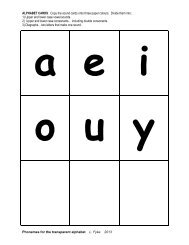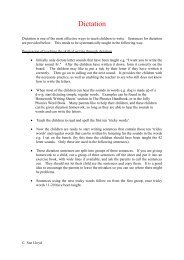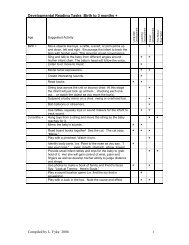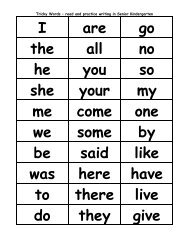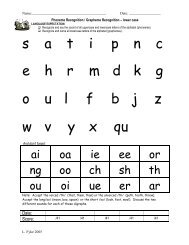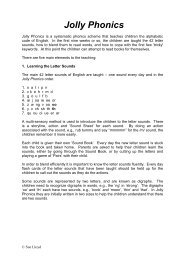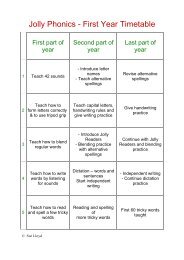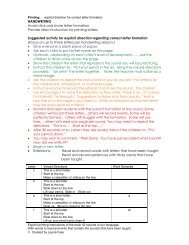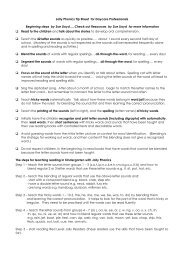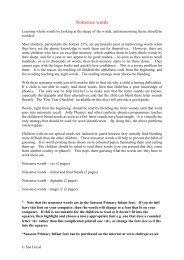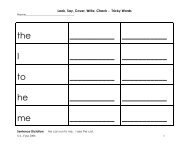Research data.pdf - Primarily Learning
Research data.pdf - Primarily Learning
Research data.pdf - Primarily Learning
Create successful ePaper yourself
Turn your PDF publications into a flip-book with our unique Google optimized e-Paper software.
Canadian Study – Sumbler and Willows 1996 –<br />
synthetic phonics (Jolly Phonics) classes compared<br />
to whole language/eclectic classes.<br />
large numbers of children, all 265 non reading, controlled and<br />
equal comparison groups<br />
After 6 months monitoring and testing:<br />
Synthetic group – Av. reading – 8 months ahead of chronological<br />
age<br />
Eclectic group - Av. reading - same as chronological age<br />
Synthetic group - Av. spelling – 5 months ahead of chronological<br />
age<br />
Eclectic group - Av. spelling – 16 months behind chronological<br />
age<br />
Synthetic group – Av. nonword reading – same as chronological<br />
age<br />
Eclectic group - Av. nonword reading – 2 months behind<br />
chronological age<br />
Only two activities were significantly related to subsequent reading<br />
and spelling success: they were 'phonics' (which included all<br />
phonics activities involving print) and letter formation (which<br />
involved pronouncing letter-sounds while writing the letter shapes)
England - Stuart 1999 – Jolly Phonics compared to<br />
holistic method (Big Books)<br />
large numbers of children, 86% foreign language speakers, controls<br />
and well matched comparison groups<br />
tested after 12 weeks and one year later<br />
Results at the end of 1 year 3 months:<br />
Synthetic group – Av. reading – 11 months ahead<br />
Big book group - Av. reading - 2 months ahead<br />
Synthetic group - Av. spelling – 1 month ahead of chronological<br />
age.<br />
Big Book group - Av. spelling – 11 months behind chronological<br />
age<br />
Jolly Phonics children also significantly ahead on comprehension
Scotland- Johnston, R. and Watson, J (1998) –<br />
Accelerating Reading Attainment: The<br />
Effectiveness of Synthetic Phonics. Interchange 57.<br />
The Scottish Office Education and Industry<br />
Department. Copies can be obtained from the following website:<br />
www.hmis.scotoff.gov.uk/riu<br />
<br />
<br />
<br />
although slightly different to Jolly Phonics – the principles are the same.<br />
large number of children, controls and good comparison groups.<br />
three methods compared:<br />
1. 'Analytic phonics' (letter-sounds taught by analysing the initial sounds<br />
heard and seen in whole words)<br />
2. 'Phonological awareness plus analytic phonics' (oral training in phoneme<br />
and rhyme skills for first 10 minutes, followed by letter-sound teaching<br />
identical to 'Analytic phonics' for the final 10 minutes)<br />
3. 'Synthetic phonics' (introduced to letters and their sounds in isolation,<br />
taught how to sound and blend all the letters in a printed word, and taught<br />
how to segment oral words into sounds in order to spell using letters)<br />
<br />
after 16 weeks:-<br />
- Analytic phonics – Reading Av. - at age level<br />
- Spelling Av. – 2 months below<br />
- Phonological awareness plus analytic phonics<br />
- Reading Av: at age level<br />
- Spelling Av: 1 month below<br />
- Synthetic phonics – Reading Av: 7 months above chronological age.<br />
- Spelling Av: 9 months above chronological age.<br />
<br />
<br />
after the testing, the first two sets of children were taught with synthetic phonics.<br />
All the groups then ended up with much the same results for reading and<br />
comprehension. However, the spelling was significantly higher for the original<br />
synthetic group and this group also had no child more than a year below<br />
chronological age, whereas the others did have a few.<br />
the researchers concluded that it was not the pace but the method of letter-sound<br />
teaching that was the crucial factor
Accelerating Reading and Spelling with Synthetic<br />
phonics: A Five Year Follow Up – Scotland –<br />
Johnston, R. and Watson, J<br />
at the end of Primary 2 (English Year 1), the 264 children available<br />
for testing who had been taught by the synthetic phonics method<br />
(1998) were reading and spelling on average eleven months ahead<br />
of chronological age<br />
at the end of Primary 5 (English Year 4), the children who had<br />
been taught by the synthetic phonics method were reading, on<br />
average, 26 months ahead of chronological age<br />
spelling and comprehension scores were significantly above<br />
chronological age<br />
boys in Primary 4 & 5 were a significant seven months ahead of<br />
girls for reading<br />
* www.scotland.gov.uk/library5/education/ins4-00.asp
A seven year study of the effects of synthetic<br />
phonics teaching on reading and spelling<br />
attainment<br />
www.scotland.gov.uk/library5/education/ins17-00.asp<br />
Word reading - 3 years 6 months ahead of chronological age<br />
Spelling – 1 year 9 months ahead of chronological age<br />
<br />
Reading comprehension - 3½ months ahead of chronological<br />
age (Clackmannanshire children were from the most deprived 10% of the<br />
population)<br />
Boys reading 9.5 months ahead of girls
* St Michael's Primary School, Stoke Gifford –<br />
a large primary with low entry assessment<br />
94% achieved Level 4 (KS2 SATs) compared to 77%<br />
nationally<br />
65% achieved Level 5 (KS2 SATs) compared to 29%<br />
nationally<br />
No children below Level 3B (KS2 SATs) (including a child whose<br />
intellectual ability was below the 1st percentile) compared to 7% Level 2<br />
and below nationally<br />
33.3% boys achieved Level 5 (KS2 SATs) compared to 11%<br />
nationally<br />
no significant difference in literacy between boys and girls;<br />
no significant difference between children with summer birthdays and<br />
others;<br />
no children with English as an Additional Language on the SEN<br />
register;<br />
no significant difference in literacy skills between children eligible for<br />
free school meals and others.<br />
* If all schools followed the example of this synthetic<br />
phonics school then most of our literacy problems in<br />
schools would be solved.
Jolly Case Studies – at the end of one year of<br />
schooling<br />
Deerpark Primary, Clackmannanshire -<br />
Av age: 5.9 Reading Age: 6.8 Spelling Age: 6.11<br />
Birstall County J&I School, West Yorkshire -<br />
Av age 5.5 Reading Age: 6.7<br />
St Michael's Primary School, Stoke Gifford –<br />
Av age: 5.4 Reading Age: 5.11 Spelling Age: 5.11<br />
Our Lady of Lebanon College, Sydney -<br />
Av Age: 5.8 Reading Age: 6.8 Spelling Age: 6.9




